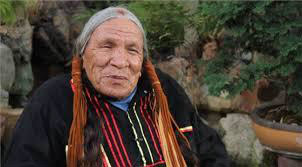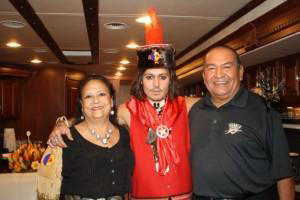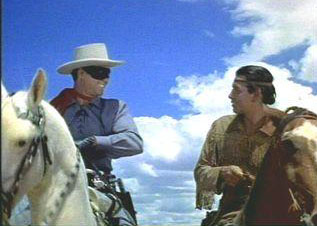NDN Tonto: Back Story
Roy Cook, edit
 When
Saginaw Grant was in the first grade, he played the role of a reindeer
in his school's Christmas play.
When
Saginaw Grant was in the first grade, he played the role of a reindeer
in his school's Christmas play.
Decades later, Grant,
the actor, traditional southern straight dancer and lecturer, is starring
as "Chief Big Bear" alongside Johnny Depp and Armie Hammer in
this summer's probable blockbuster The Lone Ranger.
Saginaw is a respected member of the Sac-n-Fox, Iowa and Otoe-Missouria Nations.
In 1936, Saginaw Morgan Grant was born to Sarah and Austin Grant Sr. at Pawnee Indian Hospital in Pawnee, Oklahoma. He was raised on a farm in Cushing, Oklahoma with two brothers and one sister. Having a traditional upbringing by both parents, Saginaw was especially influenced by his grandparents. His grandpa Kirvin was a strong medicine man and his other grandpa Saginaw (whom he is named after) was also a very spiritual man. They taught Saginaw their customs, culture, and traditions and the importance of this way of life. As a result, Saginaw witnessed many special ceremonies and events taught to very few.
As a young adult, Saginaw experienced all the situations both good and bad every young person faces in today's society. Yet he overcame the obstacles that challenged him, and with that he took his courage to become the man he is today. But Grant, a citizen of the Sac and Fox, Iowa and Otoe-Missouria nations, said he never endeavored to be an actor. One day in the '80s, Grant was speaking at a seminar near San Francisco. A man approached him and asked if he'd like to play a role in a car commercial. Saginaw took the role and he's been acting ever since.
 Indian
Country Today spoke with Grant recently from Los Angeles about his role
in The Lone Ranger, his cast-mate Johnny Depp, alcoholism
in Indian country, and the imperative to motivate one another.
Indian
Country Today spoke with Grant recently from Los Angeles about his role
in The Lone Ranger, his cast-mate Johnny Depp, alcoholism
in Indian country, and the imperative to motivate one another.
You've met and worked with Johnny Depp on the set of The Lone Ranger. What do you think of the controversy surrounding his role as "Tonto"?
Our people, the Native people, have always been the people to help each
other. [We] always want to encourage someone rather than to tear them
down. And these people who do this .....I don't know. I feel sorry for
them. I pity them, really. They're making it hard out here for the Native
actors who are working. Johnny Depp has a lot of respect for all people,
not just Native people, but all people. I've had a chance to talk with
him. I would suggest the people who will read this that they go see The
Lone Ranger. It's not what we.ve seen in the past. It's going
to be completely different. That's what's going to make it different.
It's not the way we were portrayed in the past episodes of the old Lone
Ranger television series. You have to see it to understand it, and to
really see what we've done. I encourage, especially our Native people,
to come and watch it.
Saginaw's interview continues with, what's been the best role of your life?
This role is the best, as "Chief Big Bear" in The Lone Ranger. I really like the part I played, even though I do get killed; I probably have died in a lot of movies I've been in. I probably hold the record there. Floyd [Red Crow] Westerman and I kind of argued about this. I said, "I died more times than you do. "That's just the way it is, I guess. I've been very fortunate because people seem to like my look, because it's an "Indian" look. I'm not a star or anything, but I've been able to stick here and have work. And I've been becoming pretty well known, especially since people found out that I'm in The Lone Ranger. They've really paid attention to me now. I feel good about it.
How do you spend your time when you're not acting?
I go to a lot of
events. I do a lot of public speaking. And I talk to my new generation
about indigenous culture. You know, we.re in a place where we're losing
our identity by not holding true to our traditions and our culture. And
when we lose our culture there will be no more Native peoples. That's
my main purpose now is to teach our young people our traditions and our
culture. We must never lose it. It's kind of strange when I talk to young
people. They don't really know what their beginning is. They need to hear
the stories that our grandpas and grandmas had. There are principles in
the stories. Every morning, I start off my day by talking to the Creator.
And these are the things I tell my young people: Keep true to who you
are. You are a Native person. You're different than all these other cultures.
It doesn't hurt to compliment somebody. This is what I teach the young
people. I go to recovery houses where men are suffering and wanting to
get away from alcohol. I know that life. I've been through it. And when
I talk to them they know I.ve had that experience that they are in or
are going through. I'm somewhat successful in my endeavor. I was at one
time an alcoholic myself, but I'm no longer an alcoholic. And it makes
me feel very proud because I'm making up for what disgrace I did bring
to my people when I was using alcohol. I try to get this across to our
people who are still suffering from it. The Creator gave us the ability
to know right from wrong. We just have to make the right decision. Today,
if we live by these principles, we can be happy.
Read more at http://indiancountrytodaymedianetwork.com/2013/06/13/conversation-saginaw-grant-chief-big-bear-lone-ranger-149885
Comanche Tribal Chairman, Wallace Coffey said about Lone Ranger
Tonto: "Commenting on the film, Coffey, who is serving his
fifth term as Comanche tribal Chairman and is the great-grandson of Comanche
leader Chief Ten Bears, says, "This is not a documentary of the Comanche
Nation, this is entertainment; but Tonto resembles a true  Comanche
warrior of the past. The movie is a modern-day portrayal of a period piece,
and is a portrayal of how Native Americans may have spoken during that
era, when English was their second language" says Coffey.
Comanche
warrior of the past. The movie is a modern-day portrayal of a period piece,
and is a portrayal of how Native Americans may have spoken during that
era, when English was their second language" says Coffey.
Coffey explained the significance of the crow on Depp's head in the movie
as reflecting a traditional Comanche dance called the Tuhu Wii, which
is translated to the Black Knife. This was an exclusive warrior society,
identified by black shawls around the waist, painted faces, and the dance
mimicked the crow, which is a symbol of warfare to the Comanche.
"Each warrior painted their face individually as a reflection of
their spirituality and visions, and no one warrior painted their face
the same," says Coffey, who has participated in the Tuhu Wii dance
by being a Point-Man. Pictured is: Coffy's Wife, Depp, and Coffy.
Depp was adopted by Comanche tribal elder LaDonna Harris in May 2012 and traveled to the Comanche Nation headquarters in September to complete the adoption ritual. Keeping with the traditional Comanche ways, Depp was presented to the tribe and Coffey completed it by dressing him in Tuhu Wii-style attire, which is a reflection of his character in The Lone Ranger movie. "But before Saginaw and Johnny Depp the role of Tonto was best associated with Jay Siverheels as Tonto, he too was an Indian.

Jay Silverheels was one of the most famous and successful Canadian actors
in the history of Hollywood. For decades, The Lone Ranger and his trusty
sidekick Tonto were pop culture symbols as universally identifiable as
Mickey Mouse. Although several different actors took their hand at portraying
Tonto, none were as well known as Jay Silverheels. He was a Mohawk from
Six Nations of the Grand River in Ohsweken just outside Brantford, Ontario.
The Lone Ranger
premiered on television September 15th, 1949, the first story taking place
over the course of three episodes. Watch it here
- Jay made history at the fourteen-minute mark as Tonto flickered into
living rooms for the very first time. The role made Jay Silverheels a
household name and brought him more work than ever... in monosyllabic
stereotypical roles, of course.
Despite the enormous success of the show, it was still for all intents
and purposes a low-budget production. Each episode was budgeted at $12,500.
Silverheels once held a one man protest, coming to set but refusing to
get into his wardrobe. According to Clayton Moore, Jay was upset that,
as stars of a hit series, they didn't even have their own dressing rooms.
Instead they had to change in a men's room at a gas station down the road
from the set. Producers got the message and the next day the men had their
own, brand new dressing rooms.

Clayton Moore was absent for the 1952-53 season, replaced by John Hart.
Hart had already played on the show a few times as a villain. Moore, the
public was told, had gone on a year's hiatus. Clayton recalled that the
director often went crazy when Jay adlibbed the lines and Clayton had
to hold him back from killing Jay. To make it worse, Jay could never remember
his lines at all. This was because he never read the script. We would
be in the middle of a scene, and there would come a pause and Jay would
ad lib something like, 'Um, that right,' or 'Me wait here, you go into
town.' The beautiful thing was that Clayton protected Jay to a fault.
The director would be screaming and Clayton would say, 'That's okay Bill,
the scene played more naturally the way it was.' And they printed it.
This is the reason that Tonto had all those throw away lines, he just
made them up without pause. Jay too, despite the simple dialogue, thought
it was the easiest job of all.